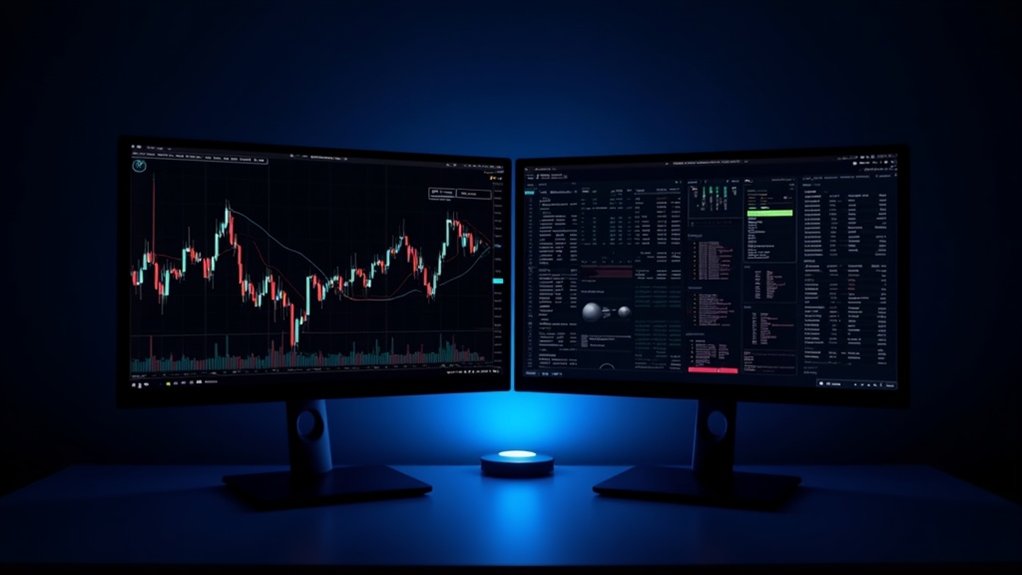Crypto whales are entities holding massive amounts of digital assets—think 1,000+ Bitcoin. They’re exchanges, early adopters, institutions, or ultra-wealthy individuals. These giants move markets with a single transaction. When they sell, prices crash. When they buy, markets surge. Their footprints appear in blockchain data as massive transfers or exchange deposits. Nearly 40% of Bitcoin sits in fewer than 2,000 wallets. That’s power you can’t ignore in the crypto ocean.
In the vast ocean of cryptocurrency, whales aren’t massive marine mammals—they’re wallets or entities holding enormous amounts of digital assets.
These digital behemoths wield significant influence over markets simply by existing.
When they move, everyone feels the ripples.
When crypto whales shift their massive digital holdings, market tremors radiate through the entire ecosystem.
No fixed threshold exists for whale status—generally speaking, owning 1,000+ Bitcoin qualifies you, or possessing more than 1% of smaller tokens.
Pretty exclusive club.
Whale identification isn’t about who you are but what you hold.
Exchanges, early adopters, founders, institutions—doesn’t matter.
If you’ve got the coins, you’re in.
And yes, you can be a Bitcoin whale without being an Ethereum whale.
Each crypto has its own ecosystem and liquidity profile.
Thanks to blockchain transparency, these giants leave footprints everywhere they go, even if their real identities remain shrouded in mystery.
The crypto sea contains diverse whale species.
Exchange wallets hold massive pooled funds.
Early adopters sit on fortunes they bought for pennies.
Institutional investors deploy strategic capital.
High-net-worth individuals make singular, market-moving trades.
Many whales originated as early crypto adopters who recognized blockchain’s potential before mainstream attention.
And market makers create the very liquidity smaller fish swim through.
Their impact? Enormous.
A single large sell order can crash prices on low-liquidity tokens.
They create “walls” in order books, artificial barriers that block price movement.
When whales transfer funds to exchanges, everyone panics—sell pressure incoming!
They reduce available supply through hoarding, making prices more volatile.
And when they time trades perfectly? Cascading liquidations follow.
Pure market chaos.
You can spot whale activity through multiple signals: sudden massive transfers, exchange deposit spikes, unusual order book patterns, and concentration metrics.
Some whales maintain market sentiment by strategically timing their substantial trades.
Tools exist specifically to track their movements.
Many whales engage in dollar-cost averaging to strategically accumulate assets while minimizing market impact.
Bitcoin shows this concentration clearly—about 40% of all BTC sits in fewer than 2,000 wallets.
That’s billion-dollar influence in surprisingly few hands.
History has repeatedly shown that when whales make big moves, markets respond dramatically.
Sometimes violently.
They’re not just participants in the crypto ecosystem—they’re apex predators.
Frequently Asked Questions
How Can Regular Investors Protect Themselves From Whale Manipulation?
Regular investors can shield themselves from whale manipulation through diversification, sizing positions relative to market volume, and maintaining cash reserves for dips.
Stop-losses help, but set them wisely—whales hunt tight stops.
Using limit orders prevents slippage, and splitting large trades reduces signaling.
Trading on reputable exchanges with strong anti-manipulation policies helps too.
The smartest move? Verify token distribution before investing. No centralized control, no whale problems. Simple as that.
What Tools Track Whale Movements in Cryptocurrency Markets?
Investors track whales using on-chain explorers like Etherscan and BscScan for raw transaction data.
Dedicated services like Whale Alert blast notifications when big money moves.
Wallet analytics platforms—Arkham Intelligence, DeBank, DexCheck—follow “smart money” patterns and portfolio changes.
Some traders use exchange flow monitoring to spot potential sell pressure.
Trading bots can even execute automatic trades based on whale movements.
Not foolproof though. Whales know they’re being watched.
Are Crypto Whales Subject to Special Regulations?
Crypto whales face increasing regulatory scrutiny, but no universal “whale-specific” regulations exist yet.
They’re caught in existing frameworks when they touch regulated systems.
Securities laws apply if their tokens qualify as securities. AML/KYC rules kick in at exchanges. Market manipulation laws can nail them for price-moving schemes. Tax authorities want their cut too.
The bigger the splash, the more regulators circle.
Most enforcement focuses on illicit activity rather than size alone.
How Quickly Can a Whale Crash a Specific Cryptocurrency?
A whale can crash a cryptocurrency alarmingly fast.
Small-cap tokens? Seconds to minutes.
One massive market order against thin order books, boom—price collapses.
Even larger cryptos aren’t immune.
BTC and ETH might take minutes to hours to feel the full impact.
Exchange deposits from whales trigger instant reactions.
Automated bots and panic sellers amplify everything.
The 2025 cases showed how brutal this can be.
Large transfers, followed by price drops within minutes.
Not pretty.
Do Whales Coordinate Activities or Operate Independently?
Evidence suggests whales do both.
On-chain data shows coordinated patterns—simultaneous exchange deposits before price drops, synchronized withdrawals preceding rallies.
They’ve got tools for this: trading algorithms, OTC desks, cross-exchange routing.
Their motivations? Price manipulation, liquidity harvesting, risk distribution.
But not all whale moves are coordinated schemes. Many large transfers are just boring custody operations. No conspiracy there.
Bottom line: some whales swim together. Others hunt alone. Market’s a complex ocean.









